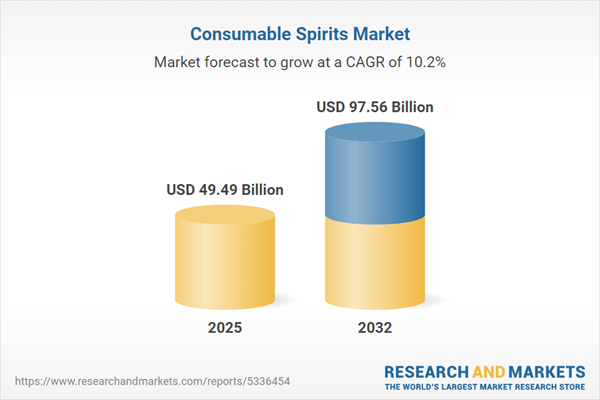Speak directly to the analyst to clarify any post sales queries you may have.
The consumable spirits market is transforming as senior decision-makers face accelerating digital disruption, shifting consumer dynamics, and stricter regulatory expectations. Stakeholders must act with agility, relying on clear insights to navigate complexity and strengthen future market positioning.
Market Snapshot: Consumable Spirits Market Size, Growth, and Emerging Trends
The global consumable spirits market is entering a high-growth phase, with revenues projected to increase from USD 44.81 billion in 2024 to USD 49.49 billion in 2025, and forecast to reach USD 97.56 billion by 2032. This reflects a compound annual growth rate (CAGR) of 10.21%.
Expansion is supported by diversified portfolios spanning premium to value segments. Leading brands are adopting digital engagement strategies, improving supplier-buyer connections and procurement efficiencies. Market drivers include demographic shifts, sustainability imperatives, and new regulatory frameworks, which collectively shape regional trends and require leaders to adapt go-to-market strategies swiftly.Scope & Segmentation: Market-Driven Opportunities for Leaders
- Product Types: Categories such as Brandy, Gin, Liqueurs, Rum, Tequila, Vodka, and Whiskey underpin product development and allow companies to reach varying consumer segments across geographies and age groups.
- Distribution Channels: Channels include off trade (liquor stores, supermarkets, digital retailers), on trade (bars, restaurants), hybrid, and online platforms, collectively broadening market access and consumer engagement.
- Price Tiers: Premium, Standard, and Value groupings enable effective product and marketing positioning tailored to target audiences and regional market conditions.
- Package Types: Glass bottles, PET bottles, and cans help companies support sustainability initiatives and maintain efficiency in logistics and shelf presence.
- Consumer Age Groups: Targeted marketing for age brackets 21–30, 31–40, 41–50, and 51+ advances generational product innovation and informed engagement.
- Gender: Gender-based analysis informs product design and communication strategies for more effective outreach and resource deployment.
- Flavor Profiles: The split between flavored and unflavored spirits reflects innovation in consumer palate trends, promoting tailored product development.
- Consumption Occasions: Everyday use, gifting, celebrations, and food pairings create collaboration avenues for retailers and foodservice partners, deepening channel partnerships.
- Regional Coverage: The Americas, Europe, Middle East, Africa, and Asia-Pacific yield unique demand drivers and compliance requirements that necessitate tailored, region-specific approaches and regulatory insight.
- Company Profiles: Benchmarking insights from Diageo plc, Pernod Ricard SA, Bacardi Limited, Brown-Forman Corporation, Beam Suntory Inc., Constellation Brands, Davide Campari-Milano N.V., Rémy Cointreau S.A., The Edrington Group Ltd., and The Sazerac Company, Inc. inform partnership or competition strategies.
Key Takeaways: Strategic Considerations for Senior Leaders
- Rich storytelling and intentional brand positioning engage premium customers, while the ongoing diversification of channels prioritizes digital interaction for B2B market participants.
- Detailed consumer analytics allow for rapid adjustments in product offerings and campaign localization, supporting stronger alignment with demographic and regional patterns.
- Adoption of advanced ecommerce and procurement platforms is crucial for improving supplier relations, operational workflows, and response speed in volatile markets.
- Integrating sustainable practices, from packaging to supply sourcing, reinforces brand authority as interest from stakeholders and regulatory bodies increases.
- Managing supply chains with resilience and adaptability becomes vital as market and compliance landscapes shift, minimizing risk from region-specific challenges.
- Expanding collaboration with retail, hospitality, and influencer networks unlocks targeted campaign opportunities and fortifies business buyer relationships across segments.
Tariff Impact: Navigating Regulatory Shifts and Supply Sourcing
Adjusting to evolving tariffs in the United States, manufacturers are reevaluating supply strategies. Emphasizing domestic production, fostering connections with local craft producers, and prioritizing transparent communication enhance operational flexibility and support consistent market supply during regulatory changes.
Methodology & Data Sources: Rigorous and Actionable Market Insight
Research for this consumable spirits market report integrates insights from executive-level interviews, official regulatory documents, industry association data, and validated third-party analytics. This approach ensures comprehensive, actionable intelligence for senior leaders evaluating growth and risk.
Why This Report Matters
- Enables executives to align investment priorities and market strategies as sector trends evolve and new opportunities emerge.
- Provides recommendations for strengthening operational resilience, improving distribution, and advancing sustainability within the consumable spirits market.
- Supports leaders addressing digital transformation, monitoring consumer evolution, and building strategies for lasting competitiveness.
Conclusion
This report delivers a clear view of market segments, regulatory shifts, and industry trends, enabling leaders to drive sustainable growth while proactively addressing emerging risks and opportunities in the consumable spirits sector.
Additional Product Information:
- Purchase of this report includes 1 year online access with quarterly updates.
- This report can be updated on request. Please contact our Customer Experience team using the Ask a Question widget on our website.
Table of Contents
3. Executive Summary
4. Market Overview
7. Cumulative Impact of Artificial Intelligence 2025
Companies Mentioned
The companies profiled in this Consumable Spirits market report include:- Diageo PLC
- Pernod Ricard SA
- Bacardi Limited
- Brown-Forman Corporation
- Beam Suntory Inc.
- Constellation Brands, Inc.
- Davide Campari-Milano N.V.
- Rémy Cointreau S.A.
- The Edrington Group Ltd.
- The Sazerac Company, Inc.
Table Information
| Report Attribute | Details |
|---|---|
| No. of Pages | 181 |
| Published | November 2025 |
| Forecast Period | 2025 - 2032 |
| Estimated Market Value ( USD | $ 49.49 Billion |
| Forecasted Market Value ( USD | $ 97.56 Billion |
| Compound Annual Growth Rate | 10.2% |
| Regions Covered | Global |
| No. of Companies Mentioned | 11 |









